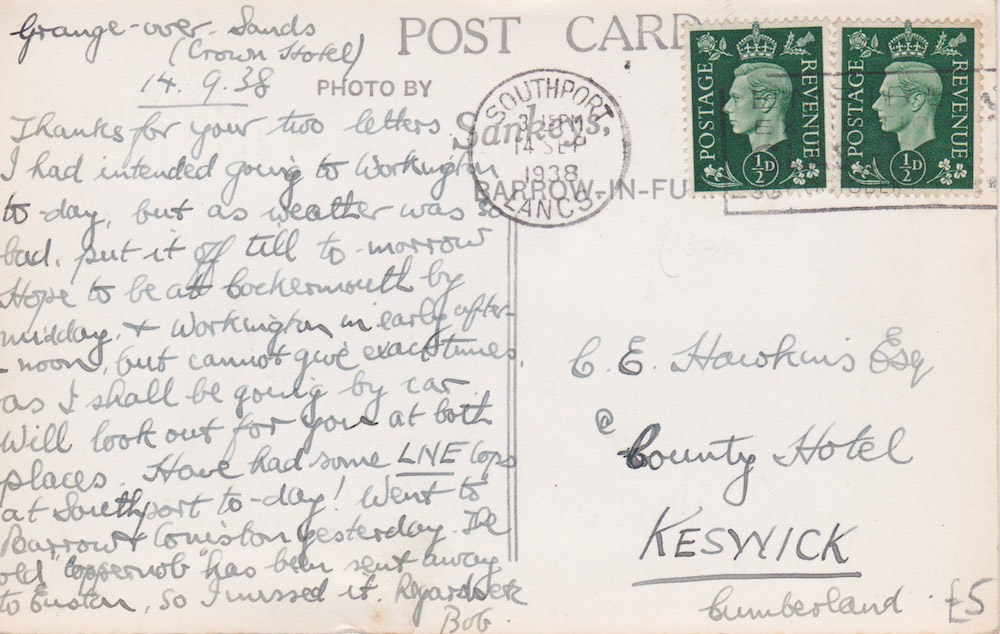Furness Railway 175
On Saturday 17th July 2021 Barrow celebrates its annual Festival of Transport – this year also marks the 175th anniversary of the opening of the Furness Railway.


To celebrate this exciting event we have partnered with Cumbria Community Rail and Cumbria Railways Association (CRA) to share Sankey Images of the Furness Railway.
The pictures you will see in this exhibition were captured by Edward Sankey in the early 20th century. Edward Sankey founded his photographic business in Barrow-in-Furness in the early 1900’s and by 1904 was appointed as the official Furness Railway Photographer, a job he held until 1923. During this time period, Edward took hundreds of images of the Railways across Cumbria and Lancashire and for this exhibition we have selected a few of the ones he took in his hometown of Barrow.
Over the last few weeks we have shared these images with members of the CRA and the Sankey Volunteers, all of whom have been researching the stories behind the photographs.
We hope you enjoy the pieces of writing they created to accompany each photograph. Just scroll down to find out more!

Coupling Competition
Peter Laird
The annual coupling competition was instituted by Furness Railway in 1887 for Guards, Shunters and Porters and was customarily held on Good Friday each year. The competition was to couple and uncouple 12 wagons in the fastest time.
A Mr W.A. Robinson won the challenge cup given by Mr FJ Ramsden in a time of 46 seconds in 1920. A Mr B Armistead won on 1921 in 45 2/3 seconds and again in 1922 in 50 seconds.
Maybe this is one of those gentlemen?
There are two other similar photos in the Sankey albums.

Interior Of Barrow Central Station
Don Jary
This picture shows a fascinating shot of the inside of Barrow Central station early in the 20th century – including the person with a tea urn trolley probably serving passengers for the awaiting train and milk churns awaiting collection on the other platform – a sight not seen today! This lofty, imposing building with an overall roof was the first through station in Barrow.
Opened in 1882, it survived until bombed in May 1941, when the heavily damaged roof was removed. The roofless platforms remained until 1958 when a new station, simply named “Barrow” was opened and remains in use today.
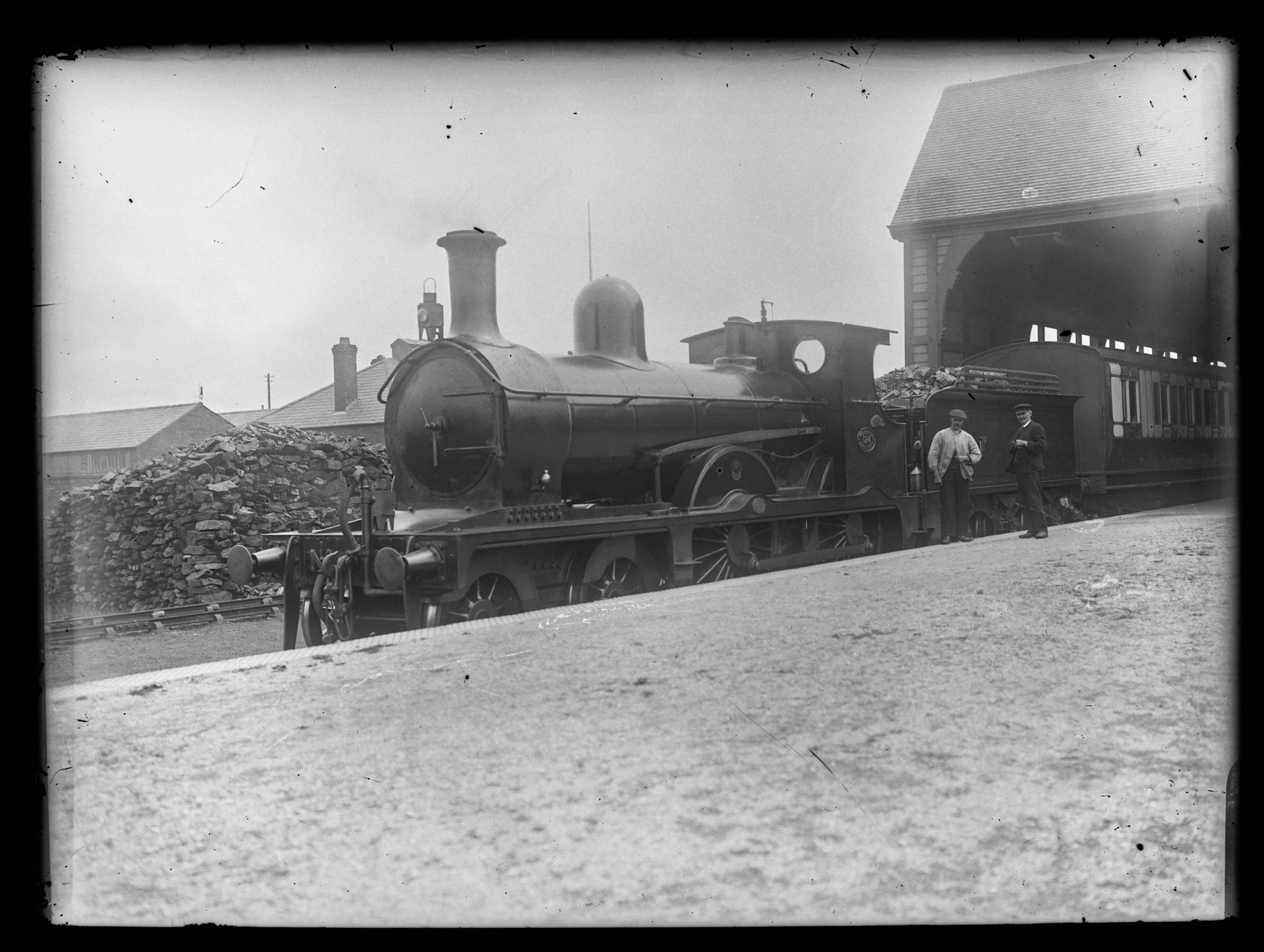
Furness Railway 4-4-0 No 124. Barrow Island.
Peter Naylor
Ramsden Dock station, Barrow Island, was one of only a handful of Furness Railway stations with a ‘train shed’ – other examples include Barrow Central, Coniston, Foxfield and the original Ulverston terminus.
A passenger train awaits duty – perhaps when the Fleetwood steamer arrives with tourists for the Lakes. Its blue and white stock is headed by smart, Indian Red 21 (K2) class 4-4-0 locomotive number 124, tender full and ready for the day’s work. Built by Sharp, Stewart & Co. of Manchester in 1900, this design, nicknamed Larger Seagulls, proved an effective passenger loco on the Furness.
A large pile of coal is stored in front of dock estate buildings; on the platform, the driver and fireman stand looking towards the camera.

Furness Railway Horse
Martin Bates
All Buffed Up
This young groom has turned out the horse in polished brasses, quite possibly for the annual Hospital Parade in Barrow. There are five contemporary images of different horses and grooms, all similarly turned out and other pictures of horses, in tandem (one ahead of the other), pulling the Furness Railway Float in 1909.
In this period, before WW1, grooms, porters and carters were a key element of the railway companies, to enable deliveries door to door. The high standards on the railway were also maintained in the stables as can be seen in the image.
The image was taken in the yard beside the stables off the Strand by the Buccleuch Dock sidings, Barrow-in Furness. The location is still marked today by a modern decorative archway at the very end of Dalton Road, adjacent to the Morrison’s supermarket.
The photographer’s own father was a horse keeper for the Furness Railway in Barrow but retired in 1899, so is not in one of the images as initially thought.

Piel Station and Roa Island Hotel
Don Jary
The right of this picture shows Piel station platform and buildings in the early 20th Century. The station buildings date from around 1868, although the line had opened some years earlier. In the left of the picture, is the Roa Island Hotel. From nearby Piel Pier there were connections into ships going to and from Fleetwood – amongst other places. The line to Rampside and Piel Island was part of the very early plans of the Furness Railway. This was because originally there was no railway line from Barrow to Lancaster and beyond. Therefore, there was a need to have sea services to connect with places in Lancashire and beyond. The line to Piel Island closed in 1936.
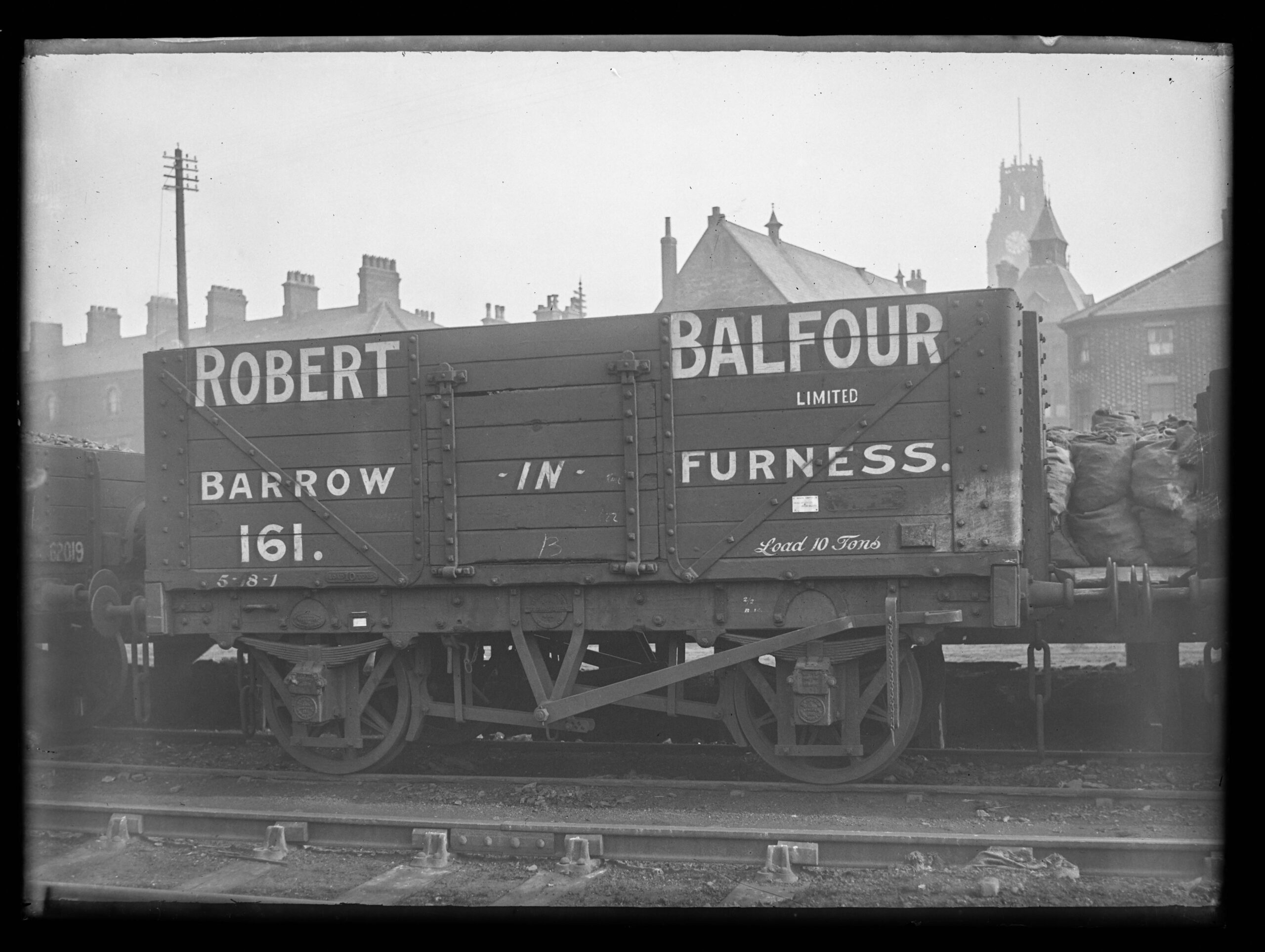
Balfours Private Owners Coal Wagon
Dave Richardson
This photograph shows a coal wagon belonging to Robert Balfour Ltd, standing in the railway coal yard on Hindpool Road in Barrow. Balfour’s involvement in the coal trade appears to date from around 1869 when he was the Barrow agent for a firm of coal merchants based in Lancaster. By 1882, Balfour had taken over the Barrow part of the business himself and was operating from No 34 Strand. Following his death in 1910, Balfour’s executors continued trading and the firm later became a private limited company. It was still trading in 1931. By the 1920s the firm was supplying coal for household, manufacturing and bunkering purposes, sourced from the Yorkshire, Lancashire and Cumberland coalfields.

Furness Railway General Manager Mr Aslett
Don Jary
Alfred Aslett (1847 – 1928), seen wearing a top hat, (less common now!), was appointed General Manager of the Furness Railway in 1895. Before coming to the Furness Railway, he was General Manager of the Cambrian Railway in Wales. During his period at the Furness, he presided over a rise in the prosperity of the company, through a new upsurge in the local iron trade, the growth of passenger traffic – particularly by promoting tourism, and reductions in railway operating costs. His tenure also saw the introduction of new, modern coaches which helped the passenger business growth and the re-opening of the Barrow to Fleetwood steamer service. He resigned in early 1918 at the age of 71.

Barrow Station Interior
Jean McSorley
An image of Barrow Central Station, taken around 1910. To the modern eye the photograph shows an unhurried place in a much quieter age, but it was nothing like that.
This station was the main travel hub for a busy town; a place many thousands passed through every year.
At the time railways were the means by which most working people in Furness got to enjoy a day out, away from the humdrum of daily life: Cartmel for the races, Blackpool for the shows and the lights, Windermere for a sail on the ferry. The train journey itself, with the sound – and sight – of those wonderful steam engines, with its lovely views en route, were exciting. On such days, happy memories were made.
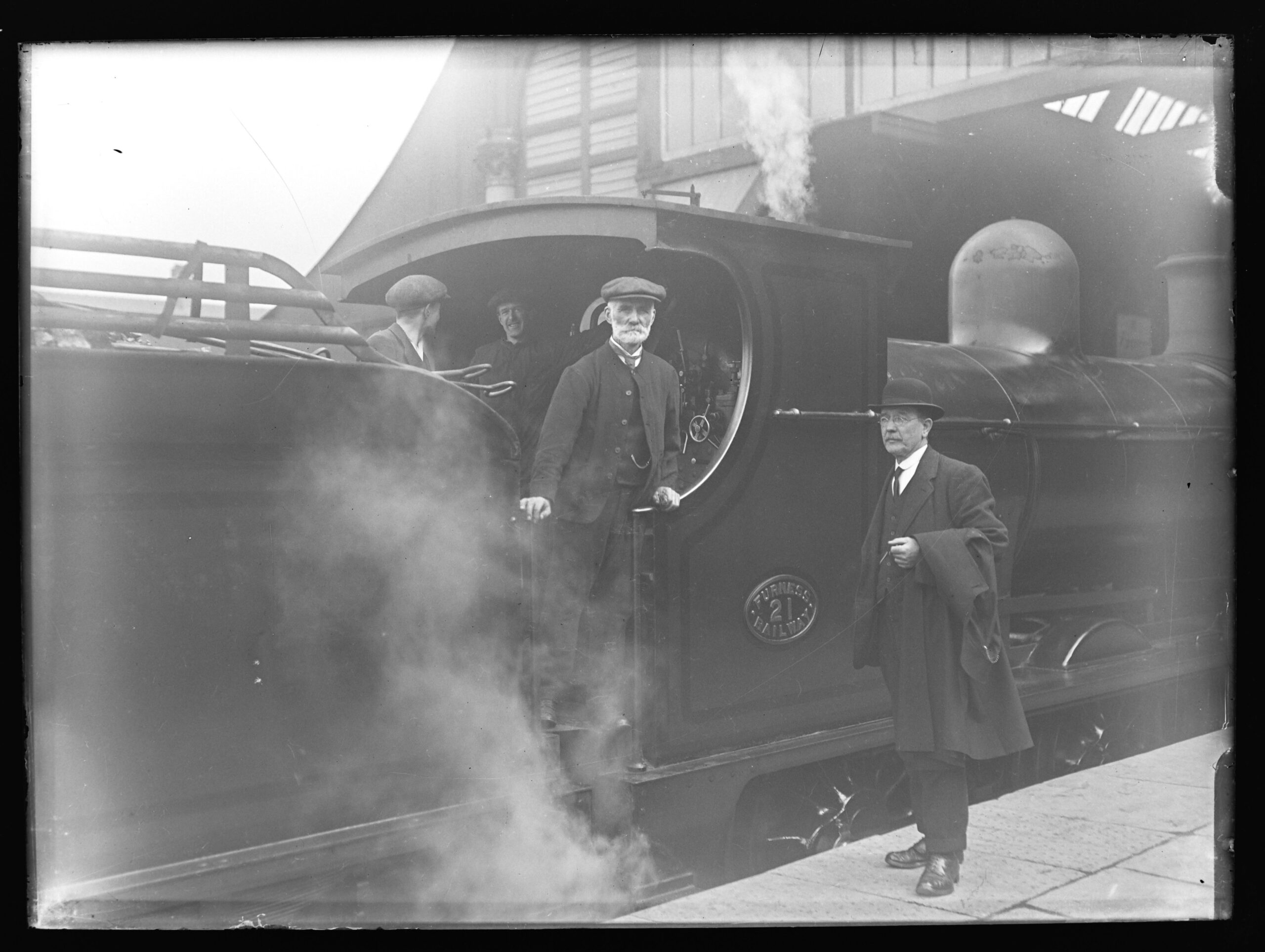
Loco FR 21 Crew
Geoff Holme
Locomotive 21 is seen at the north end of Barrow Central station on platform 1. With the inspector watching on the driver Jim Whittam is looking for the signal clearing to go. Mr Whittam from a railway family was born at Carnforth on 4th September 1863 and by 1911 was living at Paradise Street, Barrow as a locomotive fitter, and chargehand Loco Dept in May 1916.
Locomotive 21 was built by Kitson & Co., of Leeds and delivered 7 May 1918 at a cost of £6115. This modern highly competent class of locomotives ran to 19 examples built between 1913 and 1920 and one example was in service for 43 years. Number 21 had a much shorter life and was withdrawn in 1930 after only 12 years, a victim of the depression when if a non standard loco needed major work it was withdrawn.

0-6-2T and train at Ramsden Dock
Neil Smith
A Furness Railway train pulls out of Ramsden Dock Station on Barrow Island, where trains connected with sailings to Fleetwood, Belfast, and the Isle of Man.
This photo dates after 1904, when locomotive No 102 entered service.
This class of locomotive was banned from working fast passenger trains after a number of derailments, however on this occasion No. 102 does have “express passenger” headlamps!
Close examination suggests some Edwardian hi-jinks were underway… The man leaning from the first carriage appears to be holding a golf putter. Is he planning to flick off the cap of the FR minder stood by the tracks, a second or so after the shutter clicked?!

Old Coppernob, Central Station. Barrow.
On 14th September 1938 this postcard was posted to Keswick:
Grange-over-Sands (Crown Hotel)
Thanks for your two letters. I had intended going to Workington today, but as the weather was bad, put it off until tomorrow. Hope to be at Cockermouth by midday and Workington in early afternoon, but cannot give exact times as I shall be going by car. Will look out for you at both places. Have had some LIVE/LNE? Lops??? At Southport today! Went to Barrow and Coniston yesterday. The old “Coppernob” has been sent away to Euston, so I missed it.
Regards etc Bob
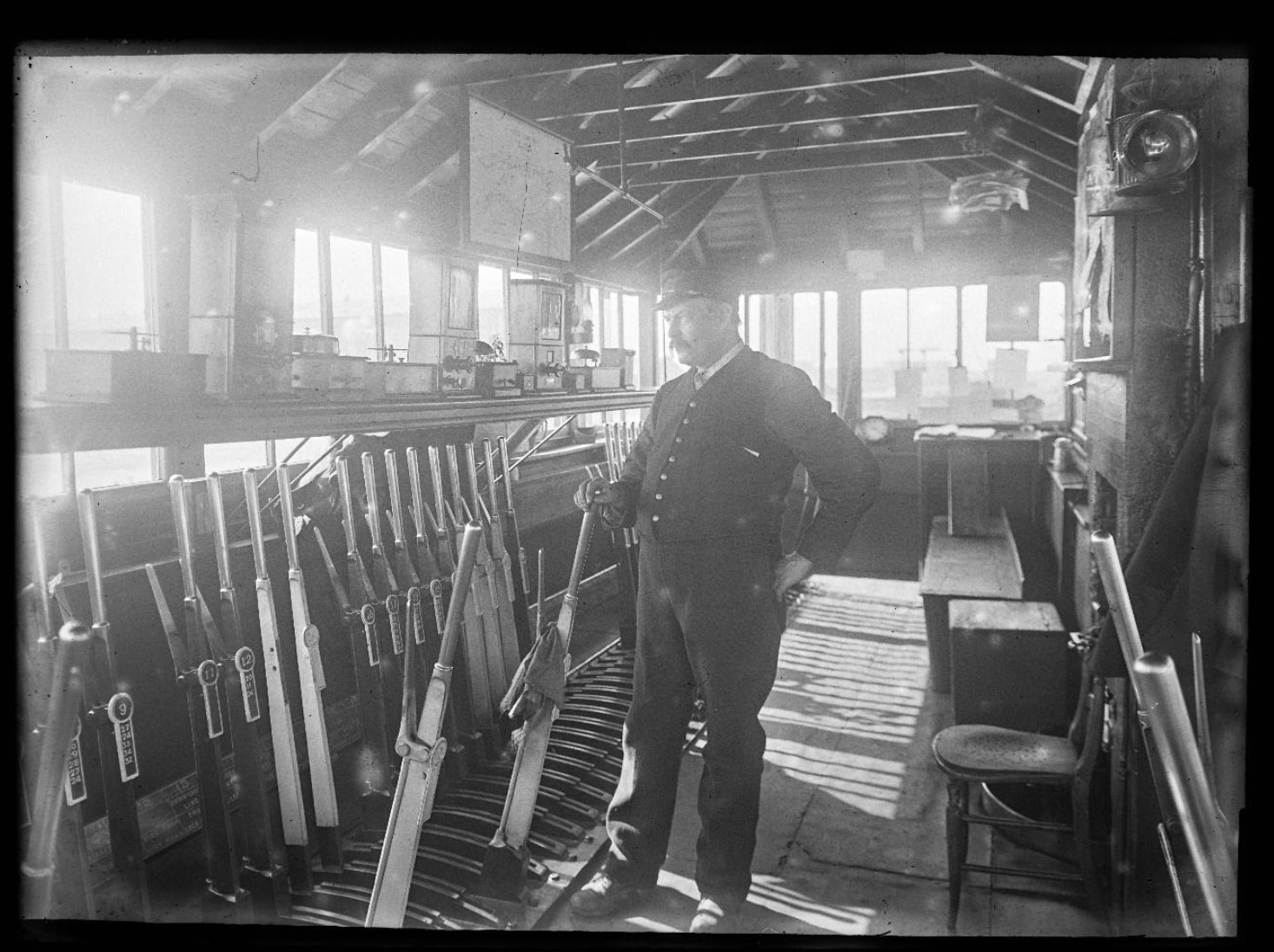
Signal Box Interior, Barrow Island
David Stubbins
This photo shows a typical signal box of which many are still in use today in Cumbria.
The levers are used to operate points, which determine which direction the trains will go, and signals which give the authority for trains to proceed. The levers are interlocked to prevent errors and ensure that a signal for a particular direction cannot be released unless all the other levers dependant on it are in the correct position.
In this photo the nearest lever to the camera, number 9, requires levers 27, 24, 33, 34 and 32 to be released.
The cloth on the lever being held by the signalman was an item which most signalmen used to protect their hands.

Barrow Central North Signal Box Exterior
David Stubbins
This signal box is sited just to the north of what is now called Barrow Station.
Signal boxes were used to control the direction and movement of trains, and the signalman had a very important job.
This signalman is standing at the window of his box to observe the passing of a train. He had to ensure that he saw the red tail light attached to the passing train so he could be sure that no carriages had become detached.
He would then record the details of the train in a book in his box.

FR 0-6-0. No.27 OIL TRAIN
Neil Smith
One of the final and most powerful class of FR goods locomotive heads a long train of oil wagons, stood alongside Ramsden Dock Road, Barrow Island. Several companies began importing petroleum products via Barrow docks at the start of the 20th century, including Anglo-American, seen here. The first wagon carries petrol, evidenced by the painted horizontal stripe, probably the “Pratts Perfection Spirit” brand, while those following that can be identified carry Royal Daylight Lamp Oil (paraffin). An unusual “pillar box” double vertical tank wagon is 7th in the train. The posed train and men suggests a noteworthy occasion, but it is unclear what that was. The wagons are far from clean, so wasn’t marking a “new train”.

Ticket Barrier
LES GILPIN
The ticket checker stands smartly at the ticker barrier at Barrow Central station at some point possibly in 1914 before the start of World War 1. The posters in the background are one of the Furness Railway’s well-known and colourful English Lakeland posters and one announcing the opening of a new refreshment room at Seascale station. This latter was authorised in May 1913.
The young man is smartly dressed in his olive green uniform with ticket nippers at the ready to check that anyone venturing onto the station platform has a valid ticket. He would also collect used tickets, which would be sent off to the Audit department of the Furness Railway where numbers of sales were matched with the tickets collected. It is a role that would be carried out for around 90 years, from when Barrow Central opened in 1882 until well into the days of British Rail.
Beyond the steel gates is the large booking hall; part of the alterations made to Central station around 1900.

Barrow shed cleaner
LES GILPIN
Furness Railway Locomotive Cleaners at Barrow shed standing on 0-6-0 loco number 24, with sister loco number 21 behind.
17 men, mostly young men with at least two possibly not long out of school, given they appear to be wearing school caps. Apart from one chap in the front of the middle wheel of the locomotive, who is possibly the leading cleaner, all could have progressed through the ranks of Cleaner, Passed Engine Cleaner (passed to fire a locomotive under supervision or within the shed or yards), Fireman, Passed Fireman (allowed to drive locomotives within certain restrictions) and eventually Driver. It may be that the supervisor had been invalided out of one of these roles but retained by the Furness Railway through a level of benevolence towards its staff.
The locomotive boiler has been given a fine level of polish for a goods engine although the tender and smokebox appear to need some work. Some of the men hold cotton waste, black and oily after use. The railways must have got through tons of cotton waste for cleaning locomotives.

Askam Station
Don Jary
Askam Station, between Barrow and Kirkby in Furness, was on one of the original lines opened by the Furness Railway in 1846. The original station was very modest and named Ireleth Gate. The growth of Askam village, plus complaints about the lack of shelter and passenger facilities led to new station buildings in the picture being opened in April 1868. The station also had a goods shed (seen in the far left of the picture).
Askam station today retains many of the features seen in the picture, including the signal box and station buildings. The level crossing gates have now been replaced by modern lifting barriers. An interesting puzzle, the photo has been taken from an elevated position, but where?


The Festival of Transport in Barrow
To find out more about the Festival of Transport and to see how you can get involved on Saturday 17th July, visit the Festival of Transport Website. Cumbria Railways Association will be holding a special archive display in the Dock Museum which will also include a collection of Sankey photographs.
Special thanks
Special thanks go to Don Jary, David Stubbins and from the Cumbria Railway Association (CRA) for inviting their members to get involved with the project. We also thank Dave Richardson and Les Gilpin, CRA members for responding to an image.
Thanks goes to Sankey Volunteers who have dedicated so much time and effort into the Sankey project. We give special thanks to Geoff Holme, Jean McSorley, Martin Bates, Peter Naylor and Peter Laird who have taken part in this exhibition.
We also thank BBC Radio Presenter Neil Smith who has responded to two Sankey Railway Images.
Thank you to Kerstin Esbjornsson from Community Railway Cumbria who has helped support connect us all to make this exhibition possible.
Thanks to our funders
Previous
Next
![]()

